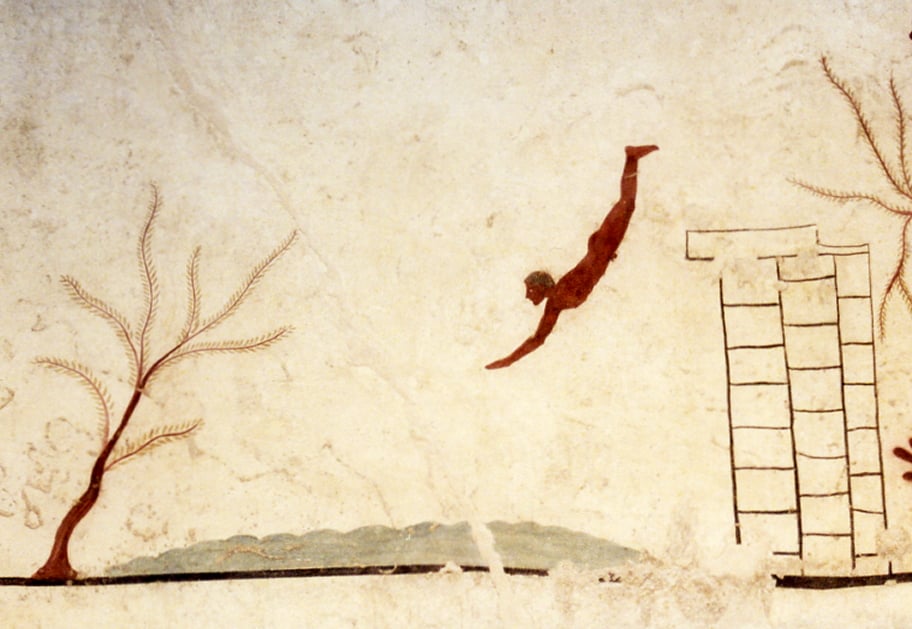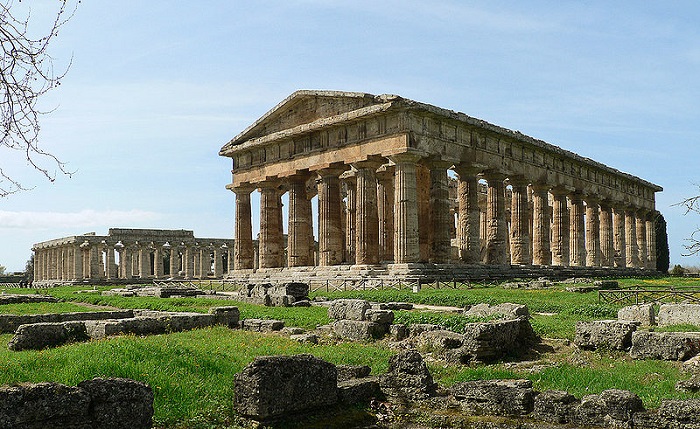
A German archeologist has allegedly solved the mystery of the ancient Greek Paestum swimmer. The debate has endured for years about the possible interpretations of the fresco. Yet Tonio Höschler, a Professor Emeritus of Classical Archeology at the Ruprecht University Karl of Heidelberg, has perhaps found the simplest and most probable of all meanings.
Paestum was an important Ancient Greek colony around 60 miles (95km) away from today’s Naples, Italy and is famous for the fresco of a young male diving into an unknown sea engraved upon the lid of his tomb. However, over the years since it was found, historians and archeologists alike have scratched their heads in puzzlement as the imagery of a youth in his prime was not what one associated normally with funerary.
Höschler, however, has written a beautifully illustrated new book that may finally provide an answer.

The mystery of the Ancient Greek Paestum swimmer solved?
The Swimmer of Paestum is Hölscher’s attempt to address questions surrounding the fresco portraying the naked diver by disassociating it from interpretations involving symbolism. What he did in his work instead was propose something equally breathtaking in its simplicity; namely, that the scene depicts one that was real once upon a time.
“Young people were seen as the hope of society…in the universe of Ancient Greece, beauty was not only a physical trait, but also a spiritual and ethical one” Höschler explained in relation to his work. “The healthy and strong body is beautiful and an instrument of human excellence.”
It is this context then that the specialist in the Greek and Roman monuments and scholar in Greek mythological imagery and city-planning interpreted the work.
Previous scholars, for example, have focused on metaphorical interpretations that linked the ancient tuffatore – a person who dives – to Pythagorean tradition, Orphics about the Beyond, salvationist ideas and metempsychosis. Others look upon it as an existential symbol of the leap from life to death or the Ancient Greek ordeal self-punishment through suicide. There has even been arguments that the boy was Etruscan rather than Greek.
Still, the uncertainty did taken away from the tomb’s magic. The filmmaker Claude Lanzmann wrote an impassioned essay about it after visiting with Simone de Beauvoir and Satre. The ‘dive plunger’ he called him, declaring “I would never have imagined being touched in the middle of the heart, upset in the depths of myself, as I was the day it appeared to me, perfect arc, as if it were endlessly plunging into the space between life and death.”
Historical interpretations of the fresco
Italian archeologist Marco Napoli discovered the tomb of the swimmer of Paestum in 1968 in Salerno in Italy’s southern province. There was no indication of whose tomb it was as there were no inscriptions. Furthermore, only inconsequential objects such as a remnant of a lyre and a small tortoise shell were found. The bones had evidently disintegrated long before, making it impossible to analyse any remains.
The handsomeness of the tomb was undisputed, nonetheless. Five large stone slabs housed the almost barren space. On them, however, were sensuous scenes of a banquet, male couples, and a symposium. Yet the one on the ceiling was the most astounding and astonishing of all. A large, stunning fresco of a naked young man soaring from a cliff into an empty space.
“The common opinion – until now – was that the young man didn’t simply jump into the sea, but made a transition from life to death. The sea was eternity” the German scholar states. “There was a general consensus surrounding the interpretation.”
Höschler however is confident about his own understanding of the figure. Namely, that “this image was simply depicting a jump has taken time to gain ground, but slowly has convinced more scholars.”
The reason, it seems, is because many academics seem to believe that Ancient Greeks feared the sea. However, that is an idea that the Professor of Classical Archeology also renounces. In his opinion, swimming was also part of Ancient Greek life.
“It was a very intense relationship, there was fear and fascination…but the Greeks swam and liked to do so. In fact, there is a Greek proverb that equates not knowing how to swim with not knowing how to read.”
A rite of passage
Another assertion Tonio Höschler makes is that the scene depicts an ancient rite of passage. In his words: “The jump portrays a young man – in transition to adulthood – demonstrating his athletic ability and courage by lounging himself into the water”
“The dive,” he further asserts “is therefore part of a rite of passage…but it’s not a metaphor.” The Professor Emeritus stresses the diver’s tan skin and his technique as proof. He also describes the sensuality and beauty of the scene and its projection of fundamental harmony.
Whether other academics will agree with the scholar is yet to be seen. Nevertheless, it does offer a new perspective on who the young man was and why we still find him so intriguing. It is for that reason as well that it is one of the most important Ancient Greek archeological sites.
See all the latest news from Greece and the world at Greekreporter.com. Contact our newsroom to report an update or send your story, photos and videos. Follow GR on Google News and subscribe here to our daily email!



